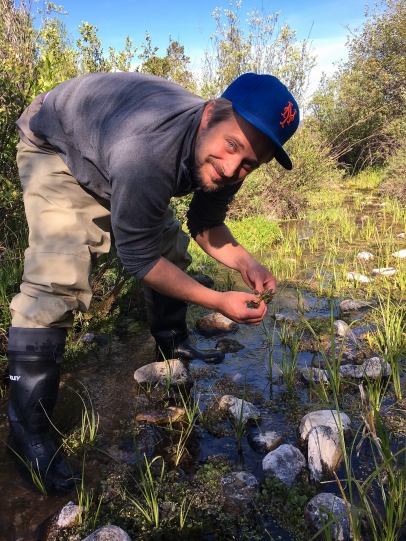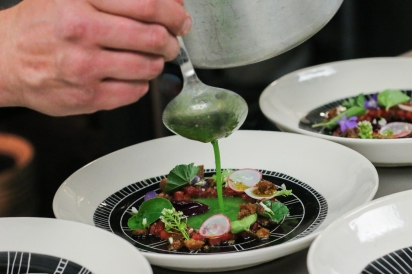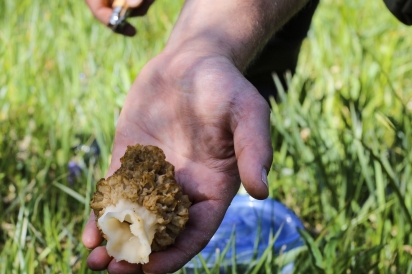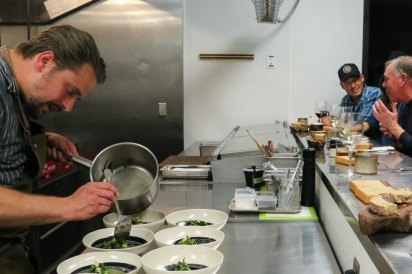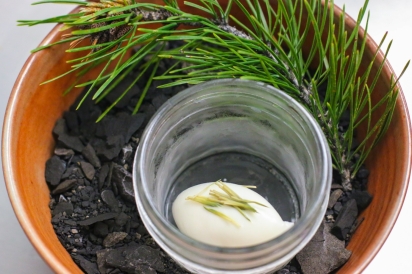STREAM TO PLATE A foraging adventure with Chef René Stein
It’s Wednesday morning, 8am sharp, and Chef René Stein is ready and waiting for me to head out on his weekly foraging expedition.
“This is the best part of my week,” Stein says as he pulls on his waders and hikes up a stream at the base of the Salt River Range near Thayne, Wyoming. Living an hour outside of Jackson, Wyoming, where Stein is the executive chef at The Rose, has its perks—most notably proximity to his favorite spot to gather ingredients for the restaurant. Today’s objectives: wild watercress, edible violets and, if we’re lucky, the last of the season’s morels.
Just a few years ago Stein was living in Brooklyn and working at Seäsonal Restaurant & Weinbar in Manhattan, where he earned a Michelin star each of the three years he was at the helm. Back then, it would have been inconceivable to have this sort of connection to gathering food for his menus.
“My chef friends back in New York, they just wouldn’t believe it,” he says.
After a career spent working his way up in several Michelin-starred fine-dining establishments in his native Germany, and later in New York, Stein headed to Wyoming with his wife, Aimee, and their young son Max for a change of lifestyle.
Stein soon became intrigued with using Old West ingredients in his cooking. His New Mountain Cuisine is a modern interpretation of local and foraged foods that uses both old and new French cooking techniques, infused with flavors from Stein’s German heritage and plated beautifully on handmade dishes and wooden vessels that evoke the outdoors. Stein’s goal—to source 90% of his ingredients locally in the summer and 80% the rest of the year—is influencing how chefs think about procuring food year-round in a mountain town.
As we wade up the mountain stream, Stein spots some tiny violets growing on the sandy banks. He pulls out a plastic container and plucks
the most perfect flowers. “These will be great on this week’s beef tartare,” Stein says, explaining that he’s constantly looking for edible
blooms to add contrast and layers of flavor to his dishes.
We arrive at the place where the stream is fed by pristine runoff from a mountain spring. Beds of wild watercress grow profusely along the banks, but Stein keeps moving, searching for his favorite patch. Suddenly, red watercress surround us and we get to work—picking the
deeply maroon variety, which has an even more peppery bite than regular watercress. Stein shows me how to harvest the watercress with its
roots still attached.
“I can do more with the whole plant,” he says. “And keeping the roots intact will keep the leaves more crisp.”
Every Wednesday night, Stein prepares a unique menu for two seatings of six diners in The Rose’s tiny kitchen, an event called Sub
Rosa. He got the idea soon after taking over The Rose, when he was moving some shelves around and pulled a seat up to the counter.
“I sat there for a long time,” he said. “I looked at the shelves and saw seats filled with diners. I wanted to take down the wall between the
kitchen and the restaurant, so the chef and diners experience the meal together.”
The early days of Sub Rosa were a lot like a secret powder day—those under-the-radar ski days when the snow is deep but the crowds are thin. Now word has gotten out that Stein is doing something very special inside The Rose kitchen and each seat is highly coveted. Visitors to Jackson would be well advised to book in advance.
Ideas for the Sub Rosa menu percolate in Stein’s brain early in the week based on what ingredients are in season at the market and in the
fields. On Tuesday night, after his two young sons go to sleep, he sits down to write the multi-course menu.
This week, Stein weaves watercress into his menu. It’s served with potato confit, wrapped like a tiny package with leeks, and as part of the Garden Velouté—a velvety sauce pooled within a ring of beef tartare that’s garnished with edible flowers and foraged greens.
Walking back to the truck, Stein stops to inspect a grassy patch under some willows next to the stream where he’s found morels in the past. We get into mushroom hunting mode, walking very slowly in circles.
“There’s one!” Stein says, dusting it off carefully before cutting it above the root, leaving a generous portion of stem behind. “Where there’s one there must be more,” we both say, wishfully. Within a few feet, there’s another golden morel, its honeycombed head gleaming in the morning sunshine. Although Stein hadn’t planned to include morels in tonight’s menu, he always leaves some wiggle room to incorporate unexpected foraging finds. Stein says the morels “will be perfect for the mushroom dish,” a mix of spring greens, preserved mushrooms and a softly poached egg.
Although it feels like a leisurely foraging outing to me, I quickly realize that Stein is on a tight schedule. Promptly at 9:30am, we leave
for Haderlie’s Farm to pick up spring garlic, root vegetables and whatever else is ready to harvest. As farmer Russ Metge gathers a box
filled with vegetables, Stein constantly picks at the weeds that grow in between the stone path and along the tilled rows on the way to the
greenhouse.
“I definitely have a weed problem,” Stein says, as he plucks a little white flower for us to sample. If broccoli were a delicate flower, this would be what it tastes like.
At 10am Stein departs for The Rose, an hour-long drive that winds through Wyoming’s Snake River Canyon. Besides a quick trip to pick
up the restaurant’s CSA box from Evergreen Farms in Smoot, Wyoming, the rest of the day is spent prepping for that evening’s Sub
Rosa dinner.
Stein prepares the 11-course menu in front of his guests, engaging them in his culinary process. The beauty of the food is striking as he hands each plate across the counter: white asparagus sorbet served in a pool of rhubarb juice; cabbage roasted until it’s caramelized, served with buttermilk, lardo and ramps; Idaho sturgeon in broth, buried beneath a pile of grilled spring garlic; a ring of beef tartare crowned with flowers and mallow, the verdant velouté poured in the center; and, finally, perfect orbs of olive oil gummy bears.
By 11pm, the last guests emerge from the two-hour tasting as if waking up from a spell of art, flavor and the delight that comes from experiencing familiar ingredients in unexpected ways. Stein scrubs down the kitchen and hits the road for the long drive home.
For Stein, cooking for guests who love food is the best part of Sub Rosa. He likens the creative process to writing a song and then performing
it in front of people.
“For me,” he says, “Sub Rosa is like a live concert every night.”
The Rose and Sub Rosa
50 W. Broadway, Jackson, WY
therosejh.com


